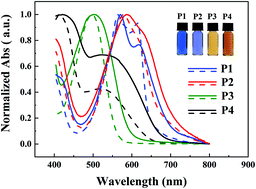3D-Printed OFETs of the 1,4-bis(3-phenylquinoxalin-2-yl)benzene-based polymer semiconductors†
Abstract
In this study, we polymerized a 1,4-bis(3-phenylquinoxalin-2-yl)benzene unit with DPP and isoindigo units to produce four new polymers and deeply investigated the influence of DPP and isoindigo units on the semiconductor characteristics, band gap, and orientation properties of these polymers. The semiconductor characteristics were measured through flexible organic field effect transistors OFET fabricated by a homemade desktop 3D printer. The polymer with thiophene-based DDP (P2) exhibits the narrowest band gap, both edge-on & face-on orientation, and the highest mobility up to 0.50 cm2 V−1 s−1. The results also prove our accomplishment of lowering the threshold of fabricating 3D printed OFET devices.



 Please wait while we load your content...
Please wait while we load your content...